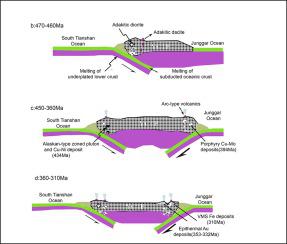当前位置:
X-MOL 学术
›
Ore Geol. Rev.
›
论文详情
Our official English website, www.x-mol.net, welcomes your feedback! (Note: you will need to create a separate account there.)
Late Paleozoic Metallogenesis and Evolution of the Chinese Western Tianshan Collage, NW China, Central Asia Orogenic Belt
Ore Geology Reviews ( IF 3.3 ) Pub Date : 2020-09-01 , DOI: 10.1016/j.oregeorev.2020.103643 Chunming Han , Wenjiao Xiao , Benxun Su , Patrick Asamoah Sakyi , Songjian Ao , Jien Zhang , Bo Wan , Dongfang Song , Zhiyong Zhang , Zhongmei Wang , Mingcai Xie
Ore Geology Reviews ( IF 3.3 ) Pub Date : 2020-09-01 , DOI: 10.1016/j.oregeorev.2020.103643 Chunming Han , Wenjiao Xiao , Benxun Su , Patrick Asamoah Sakyi , Songjian Ao , Jien Zhang , Bo Wan , Dongfang Song , Zhiyong Zhang , Zhongmei Wang , Mingcai Xie

|
Abstract The Chinese West Tianshan has a prominent position in China, with respect to mineral resources and mineral production including copper, nickel, molybdenum, iron, gold, zinc and many other mineral resources. These resources are represented by a vast array of mineral systems and deposit styles in their respective terranes spanning the Precambrian and Phanerozoic geological history. These mineral systems include VMS iron–zinc, orogenic gold, magmatic copper-nickel, porphyry copper and copper–molybdenum, and epithermal gold deposits. Some of the deposits are large and superlarge including the well-known Axi gold and Dunde iron-zinc deposits, the Zhibo, Chagangnuoer, Beizhan iron deposits, and the Katebahasu gold deposit. Apart from the above-mentioned giant deposits, several others are poorly known and/or unknown to western geoscience. The study of these mineral systems can significantly contribute to our further understanding of the metallogeny of cratons and orogenic belts, orogenic collages, and anorogenic settings. This provides additions to, and further development of, existing classifications and genetic models of mineral systems, allowing researchers to elucidate unknown or poorly studied mineral systems and formation styles found in the Chinese West Tianshan, and to discover some other important styles that appear to be missing, although they are present in other regions with similar geological and tectonic settings. Based on the study of the of the West Tianshan domain, five types of endogenous metal deposits are identified: (1) Magmatic Cu-Ni deposits; (2) Porphyry Cu-Mo deposits; (3) VMS iron deposits; (4) Epithermal Au deposits; and (5) Orogenic Au-Cu deposits. Tectonically, the development of these metal deposits was closely associated with accretionary and convergent processes that occurred in the Chinese western Tianshan collage. The formation of the deposits involved three main stages, briefly described as follows: The Jingbulake intrusion associated with the Cu-Ni deposits suggests subduction of the South Tianshan oceanic lithosphere beneath the YCTB. During the Early to Late Carboniferous, the north-dipping subduction led to the development of porphyry Cu-Au deposits, epithermal gold deposits and VMS iron deposits. In the earliest Late Carboniferous, the south Tianshan oceanic crust was probably consumed, leading to the collision between the YCTB and the Tarim Craton. The large suites of granites were widely distributed in the NTAS and YCTB, accompanied by the formation of orogenic Au-Cu deposits.
更新日期:2020-09-01


























 京公网安备 11010802027423号
京公网安备 11010802027423号